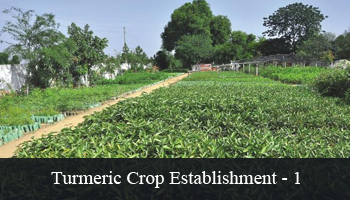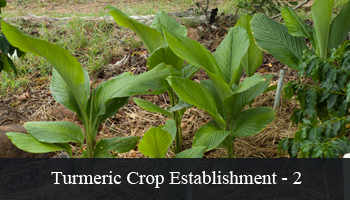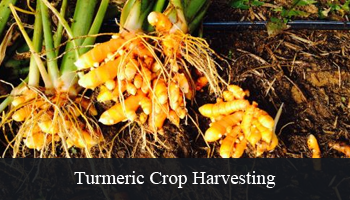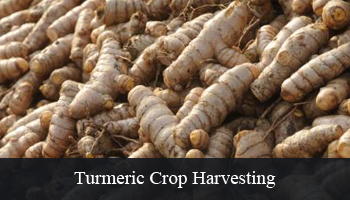Cultivation

Whole or split mother rhizomes are used for planting and well developed healthy and disease free rhizomes are to be selected. Small pits are made with a hand hoe in the beds in rows with spacing of 25 cm x 30 cm and covered with soil or dry powdered cattle manure. The optimum spacing in furrows and ridges is between 45-60 cm between the rows and 25 cm between the plants. A seed rate of 2,500 kg of rhizomes is required for planting one hectare of turmeric.
Turmeric is a tropical herb and is grown in both tropics and subtropics. It will grow luxuriantly in shade if not too dense, but it produces larger and better rhizomes in the open ground exposed to the sun. Turmeric require humid climate.
Soils for Turmeric cultivation should be rich and friable. Soils with a little higher sand content (Loams and sandy loams) are well suited. It is grown in different types of soils from light black, sandy loam and red soils to clay loams.  It grows on light black, ashy loam and red soils to stiff loams in irrigated and rain fed areas.
It grows on light black, ashy loam and red soils to stiff loams in irrigated and rain fed areas.
Planting season varies with the area of cultivation and variety. Planting is done during May-June or July- August in different tracts. Turmeric can be rotated with crops such as Finger millet, Rice and Sugarcane. It is rarely cultivated in pure stand, but is usually grown mixed with crops like Castor, Maize, and Finger millet, Onions, Brinjal and Tomato.
For turmeric number of irrigations will depend upon the soil and climatic conditions. Depending upon the soils and rainfall 15 to 25 irrigations are given in medium heavy soils and in case of light textured red soils 35-40 irrigations are needed.
Mostly for good crop and maximum output the farmers are using natural fertilizers, animal dung's, and avoid using chemicals or other harmful pesticides.
Harvesting
 Usually harvesting extends from January to March-April. Early varieties mature in 7-8 months and medium varieties in 8-9 months. The crop is ready for harvesting when the leaves turn yellow and start drying up. At the time of maturity, leaves are cut close to the ground, the land is ploughed and rhizomes are gathered by hand-picking or the clumps are carefully lifted with a spade. The picked rhizomes are collected and cleaned. The mother and finger rhizomes are separated before curing.
Usually harvesting extends from January to March-April. Early varieties mature in 7-8 months and medium varieties in 8-9 months. The crop is ready for harvesting when the leaves turn yellow and start drying up. At the time of maturity, leaves are cut close to the ground, the land is ploughed and rhizomes are gathered by hand-picking or the clumps are carefully lifted with a spade. The picked rhizomes are collected and cleaned. The mother and finger rhizomes are separated before curing.
Harvesting is done by either manually or by mechanical.
Curing (Boiling and Drying)
 Curing involves boiling of fresh rhizomes in water and drying in the sun. The objective of boiling is to destroy the viability of the fresh rhizomes and to obviate the raw odor, to reduce the drying time, to gelatinize the starch for hardening the rhizomes and give a more uniform colored product and an even distribution of color in the rhizome. In the traditional methods, the cleaned rhizomes are boiled in copper or galvanized iron or earthen vessels, with water just enough to soak them. Boiling process should be done over a slow fire until they softened. Boiling is stopped when froth comes out and white fumes appear giving out a typical odor when properly cooked, the rhizomes would be soft and yield when pressed between fingers. The boiling lasts for 45 to 60 minutes when the rhizomes are soft. Over cooking spoils the color of final product while under cooking renders the dried product brittle.
Curing involves boiling of fresh rhizomes in water and drying in the sun. The objective of boiling is to destroy the viability of the fresh rhizomes and to obviate the raw odor, to reduce the drying time, to gelatinize the starch for hardening the rhizomes and give a more uniform colored product and an even distribution of color in the rhizome. In the traditional methods, the cleaned rhizomes are boiled in copper or galvanized iron or earthen vessels, with water just enough to soak them. Boiling process should be done over a slow fire until they softened. Boiling is stopped when froth comes out and white fumes appear giving out a typical odor when properly cooked, the rhizomes would be soft and yield when pressed between fingers. The boiling lasts for 45 to 60 minutes when the rhizomes are soft. Over cooking spoils the color of final product while under cooking renders the dried product brittle.
The cooking of turmeric is to be done within two or three days after harvesting. The mother rhizomes and the fingers are generally cured separately.
The cooked fingers are dried in the sun by spreading 5 to 7 cm thick layers on bamboo mat or drying floor. A thinner layer is not desirable, as the colour of the dried product may be adversely affected. It may take 10 to 15 days for the rhizomes to become completely dry. The yield of the dry product varies from 20 to 30 percent depending upon the variety and the location where the crop is grown.




